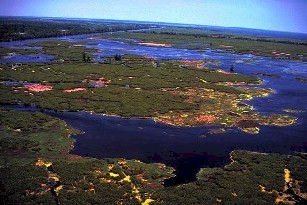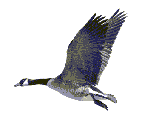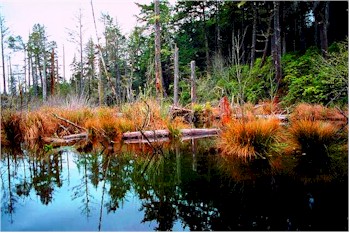|
Eco-Pros
Environmental Education on the Web
TYPES
OF
WETLANDS
What exactly
are wetlands?
Good question, because there are quite a few definitions.
Basically, a wetland is land that is covered with water or land that has
water near the surface long enough to keep the soil very moist
(waterlogged) so it can grow and support aquatic type plants.
Wetlands can also include land that is covered with water or is saturated
with water only part of the year, but has no vegetation because of
poor soil, no soil, too much salt, drastic changes in water level, or
strong wave action. These lands may be next to vegetated wetland or
deepwater habitats, such as around lakes and along rivers.
|
There are
three key elements which identify wetlands:
|
Hydrophytes
Aquatic plants
which grow in water or in soil too waterlogged for most plants to
survive
|
Hydric
soils
Soils with an abundance
of moisture
|
Hydrology
Water distribution and circulation on and below the earth's surface and in the atmosphere. |
|
|
|
5 MAJOR
WETLAND CLASSIFICATIONS

|
|
1.
Marine |
Associated
with the open ocean and high-energy coastline waters
(includes coastal wetlands, such as tidal marshes)
|
|
2. Estuarine |
Consisting of deepwater tidal habitats and adjacent tidal wetlands
that, at times, have access to the open ocean; occasionally diluting
sea water with freshwater runoff. |
3. Riverine
|
Found
along rivers and streams |
4. Lacustrine
|
Associated
with lakes |
5. Palustrine
|
May
be isolated or connected wet areas, including marshes, swamps, and
bogs |
|
The above descriptions are very
general.
Specific descriptions of classifications may be found
on the USGS and EPA links below.
|
|
Various Names for Types of Wetland Areas
|
Bog |
Fen |
Cypress swamp |
Gulf |
Estuary |
| Peatland |
Pond |
Prairie
pothole |
Salt marsh |
Vernal pool |
| Mangrove |
Riparian area |
Brackish marsh |
Tundra |
Spong |
| Baylands |
Pocosin |
Wet meadow |
Lagoon |
Stream |
| Taiga |
River |
Hardwood swamp |
Lake |
Saltflat |
| Seep |
Slough |
Freshwater marsh |
Floodplain |
Creek |
| Channel |
Wet pasture |
Intertidal mudflats |
Spring |
Reservoir |
|
|
|
|
|
 

|
"Classification of Wetlands and Deepwater Habitats of the United States"
(systems and subsystems)
To begin, click "Next Section--Marine System"
U.S. Geological Survey-Northern Prairie Research Center (includes
illustrations)
Wetlands (U.S. Environmental Protection Agency)
Definitions/identification of wetlands, types, status, facts, reasons to
protect them, functions/values, fish and wildlife, flood protection,
shoreline erosion, water quality and hydrology, threats, economics,
recreation and aesthetics, watershed planning, water quality standards,
Clean Water Act, 404 permitting, financial assistance, mitigation,
monitoring and assessment, restoration, awards, grants - and what you
can do to protect wetlands.
|
Mind -
Boggler |
|
There are many
names for various types of wetlands, depending upon the environment a wetland is
in, the type of climate in the area, the type of vegetation that
grows there, the level of the water, the types of animals it supports, whether
the water is permanent or only there part of the year, the type of soil, and other variations related to region and
local terms. A bog in one area could contain different types
of plants than a bog in another area, depending on variances such as
climate, for instance.
|
|
Therefore, the two definitions of those bogs
would
not exactly agree with each other.
|

Click on
our goose friend and catch a ride to the next page
to learn why wetlands are so important.
Mouse over
images on the website to see messages - if you see a hand, click on it.
|
|
![]()

![]()


